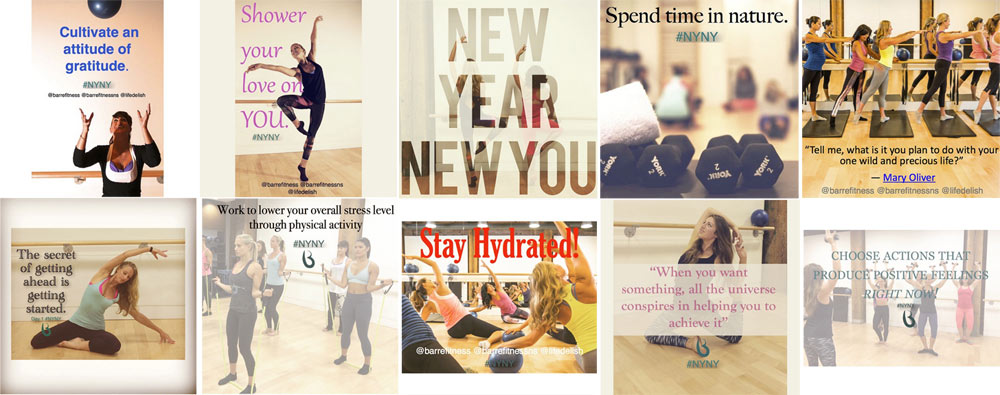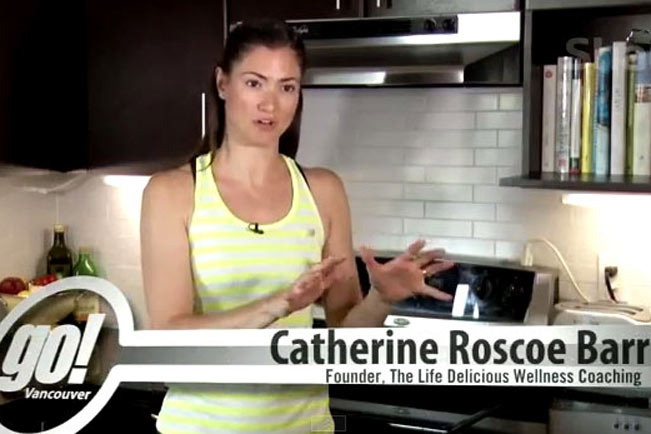
In January, I was asked to collaborate with Vancouver's Barre Fitness for their "New Year New You" campaign by sharing two dozen wellness tips and a few of my favourite inspiring quotes.
I thought I'd share them with you here!
These are some of my favourite philosophies on living well, and incorporate the pillars of my Trifecta of Wellness: stress management, exercise and nutrition.
I'd love to hear how you incorporate these tips into your life! Share your successes, struggles and aha moments on Twitter, Instagram and Facebook with the hashtag #TheLifeDelicious!
1. Reverse engineer your happiness
Instead of thinking you’ll be happy when ___ (fill in the blank), get happy now! I call it cultivating optimal brain chemistry, Danielle LaPorte calls it The Desire Map, and Shawn Achor calls it The Happiness Advantage. Whatever you call it, take a feelings-first approach by deciding to choose actions that productive positive feelings right now, like stress management, exercise and nutrition – and then watch your wildest dreams unfold before you.
In his awesome TED talk, Achor says, “Your brain, if positive, is 31-percent more productive than your brain at negative, neutral or stressed. Which means if we can reverse the formula – if we can find a way of becoming positive in the present – then our brains work even more successfully, as we’re able to work harder, faster and more intelligently.”
2. Start an anti-sedentary revolution!
The science of sedentary physiology cautions that an intense workout doesn’t cancel out the effects of low-energy-expenditure behaviours – like sitting on your couch, at your desk, or in your car – for the remaining 23 hours of the day.
See every chance to move your body as a gift, embrace formerly-tedious tasks, reframe your thoughts on chores and errands, and identify myriad opportunities to get physical!
~
“Tell me, what is it
you plan to do with your
one wild and precious life?”
– Mary Oliver
~
3. Banish the all-or-nothing mentality
It’s easy to declare the day, week, or month a write-off following one poor decision, whether it’s an unhealthy food choice or skipping your workout again. How many times have you said to yourself, “I’ll start ___ (eating better, exercising, meditating) ___ (tomorrow, next week, next year)”? What if you took just one teensy weensy step today?
Challenge yourself to reframe your mindset, to accept that every breath is a rebirth, each moment – each breath – presents the opportunity to make self-nurturing choices and start anew.
4. Squish out, don't deprive
Don’t think about your diet from a deprivation perspective. Add so many beneficial, delicious, good-for-you things that the unhealthy stuff just gets squished out.
5. Add more good
Boost your nutrition by making it your goal to add at least 2 vegetables to each meal. Aim for one deep, leafy green and another rich hue like orange, purple or red. Multi-colour meals equal a rainbow of nutrients!
~
“When you want something,
all the universe conspires in
helping you to achieve it.”
– Paulo Coehlo
~
6. Lower your stress inventory
Take an inventory of your uncomplementary stress (poor nutrition, sedentary lifestyle, negative thoughts and anxiety, toxic chemicals, toxic relationships, spiritual suffocation) and complementary stress (exercise, achieving professional goals), and work to lower your overall stress.
For example: sometimes you need gentle exercise (physical stress) if your mental stress is high.
7. Elicit the relaxation response
Take time every single day to elicit the relaxation response (the opposite of the stress response) because your body’s innate self-repair mechanisms only function when your parasympathetic nervous system is activated through the relaxation response or rest.
In addition to meditation, says physician and author of Mind Over Medicine, Lissa Rankin, “creative expression, sexual release, being with people you love, spending time with your spiritual community, doing work that feeds your soul, and other relaxing activities such as laughter, playing with pets, journaling, prayer, napping, yoga, getting a massage, reading, singing, playing a musical instrument, gardening, cooking, tai chi, going for a walk, taking a hot bath, and enjoying nature many also activate your parasympathetic nervous system and allow the body to return to a state of rest so it can go about the business of self-repair.”
~
“You must witness your behaviour
if you truly want to change it.”
– Gabby Bernstein
~
8. Drink a big glass of water first thing in the morning
After a night without water, you’re dehydrated, so drink a big glass of water when you wake up – and pay close attention to what an incredible difference this makes to every cell in your body!
9. Know your food's origins
If you think about origins, it’s so much easier to eat healthfully. Is this vegetable locally, organically, lovingly grown? How was this animal treated? Is this seafood sustainable? How far did this package travel – what is its carbon footprint?
It's difficult to truly enjoy eating something if you suspect that the way it was grown, raised or processed was seriously lacking in love and respect.
10. Create self-nurturing energy rituals
At the start of each week (I love to do this on Sundays), create energy rituals by making weekly action plans for stress management, exercise and nutrition:
- make a menu plan, a corresponding grocery list, and prep your ingredients so it’s easy to whip up healthy meals and snacks
- plan your workouts (I do a 3-day rotation of strength, cardio and flexibility) and put them in your calendar
- set aside time for YOU, whether it’s for regenerative solitude, creative endeavors, or battery-filling hobbies
~
“Freedom from obsession is not
about something you do;
it's about knowing who you are.
It's about recognizing what sustains
you and what exhausts you.”
– Geneen Roth
~
11. Cultivate an attitude of gratitude
Physician, psychiatrist and author of Change Your Brain, Change Your Life, Daniel Amen says, “The best antidepressant isn’t Prozac, it’s gratitude. If you write down three things a day that you’re grateful for within three weeks you’ll notice a significant difference in your level of happiness.”
Whether you write them in your journal or make a mental note as you drift off to sleep each night, reflect on your day and list as many things as you can that you're grateful for. This trains your brain to scan the world for positives and counteract its negativity bias.
12. Improve the quality of your sleep
Sleep is essential for repair and regeneration, and even if you’re getting enough sleep (7 to 9 hours), it may be subpar.
In a nutshell, spend at least an hour winding down at bedtime, and sleep naked (orgasms are encouraged) in a pitch black, cool, electronics-free room. In a larger shell, check out my article for the Lululemon blog on 5 surprising tips for a better sleep.
~
“Change is effortful until it becomes effortless.
Our brains like to use the path of least resistance,
which is the well-worn existing path.
Just as a river needs time to carve a canyon,
resilient new brain pathways depend
on repetitive and deeply felt experiences.”
– Dr Amit Sood
~
13. Shower your love on YOU
We can be our own harshest critics, but self-loathing and self-sabotaging behaviour get us nowhere near our goals. Embracing self-nurturing thoughts and actions allows you to be your best self – and when your battery is full you have a significantly more positive influence on the world around you.
14. Spend time in nature
In the fascinating and eye-opening book The Nature Principle: Reconnecting With Life in a Virtual Age, author Richard Louv says, “Every day, our relationship with nature, or the lack of it, influences our lives. The Nature Principle is supported by a growing body of theoretical, anecdotal, and empirical research that describes the restorative power of nature – its impact on our sense and intelligence; on our physical, psychological, and spiritual health; and on the bonds of family, friendship, and the multi-species community.”
~
“The secret of getting ahead is getting started.”
– Mark Twain
~










